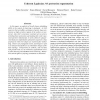Free Online Productivity Tools
i2Speak
i2Symbol
i2OCR
iTex2Img
iWeb2Print
iWeb2Shot
i2Type
iPdf2Split
iPdf2Merge
i2Bopomofo
i2Arabic
i2Style
i2Image
i2PDF
iLatex2Rtf
Sci2ools
CVPR
2008
IEEE
2008
IEEE
Coherent Laplacian 3-D protrusion segmentation
In this paper, an analysis of locally linear embedding (LLE) in the context of clustering is developed. As LLE conserves the local affine coordinates of points, shape protrusions as high-curvature regions of the surface are preserved. Also, LLE's covariance constraint acts as a force stretching those protrusions and making them wider separated and lower dimensional. A novel scheme for unsupervised body-part segmentation along time sequences is thus proposed in which 3-D shapes are clustered after embedding. Clusters are propagated in time, and merged or split in an unsupervised fashion to accommodate changes of the body topology. Comparisons on synthetic, and real data with ground truth, are run with direct segmentation in 3-D by EM clustering and ISOMAP-based clustering. Robustness and the effects of topology transitions are discussed.
Computer Vision | CVPR 2008 | Em Clustering | Isomap-based Clustering | Local Affine Coordinates | Unsupervised Body-part Segmentation | Unsupervised Fashion |
| Added | 12 Oct 2009 |
| Updated | 12 Oct 2009 |
| Type | Conference |
| Year | 2008 |
| Where | CVPR |
| Authors | Fabio Cuzzolin, Diana Mateus, David Knossow, Edmond Boyer, Radu Horaud |
Comments (0)

